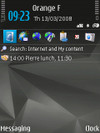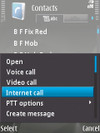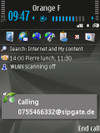Back in 2006, I reported about my pretty modest VoIP over Wifi experience with the UTStarcom F1000G. At the time, I had four major issues which is why the phone went right back into the box and hasn’t left it since:
- Voice quality was bad.
- It would only work with some Wifi access points.
- Voice quality started to deteriorate quickly when moving away from the Wifi access point. Practical use of the phone was limited to a few meters around the access point.
- The software was not very stable and the device frequently lost the network and didn’t log back on.
Now, one and a half years later, I have picked up a Nokia N95 to replace my N93, mainly because the N93’s amount of memory can no longer handle the myriad of applications I use. There are many nice extras I have discovered since and one of the major ones is the integrated VoIP client. I have to admit that I was not expecting too much due to my prior experience. However, after testing it out I have to say I am very impressed!
The Good Things

As I am already using VoIP with Internet based VoIP provider SIPgate and a Siemens Gigaset DECT to IP phone, the SIP configuration wasn’t very difficult for me and SIPgate has a very detailed description on how to configure the N95. After exiting the configuration dialog the phone automatically establishes a Wifi connection and registers with the SIP server on the Internet. Once registration is successful, a little telephone receiver icon above a globe is shown on the right of the idle screen (see Figure 1).
Once the VoIP client is registered, the user has the choice to place a standard cellular call or the use the VoIP functionality whenever dialing a phone number or when selecting a contact from the address book. In both cases, the call is established over VoIP by selecting ‘Internet Call’ in the options menu instead of "Voice Call"(see Figure 2).

In terms of voice quality I am very impressed, it is the best I have experienced so far and I am not able to tell the difference between a VoIP and a cellular call to a fixed line phone. Very impressive! Also, the stability of the implementation is great. The longest call I have used the phone for so far was 90 minutes and I can not recall a single glitch during the time. The handset gets slightly warm over time but that is not really a problem.
Another nice and very important feature is that when you leave the coverage area of the Wifi access point and later come back, the SIP client detects that the Wifi network is available again and automatically re-connects to the SIP server. That’s great since I, and probably most other people , would be too lazy to manually restart the VoIP client when coming home. I have used the SIP client for about 2 weeks now and during that time I have extensively tested incoming and outgoing calls. Both work flawlessly and the N95 has now fully replaced my DECT phone. Also, Wifi sensitivity is a lot better compared to the N93 and especially to the F1000G. Voice quality is still excellent in neighboring rooms where both the N93 and the F1000G have given up before.

Being connected to the Wifi hotspot all day long must have some impact on the battery, or so I thought. In practice, however, it doesn’t seem to be much, the battery easily lasts a full day no matter whether the phone is connected to Wifi all day or not. Talk time is also acceptable. After a 90 minutes phone call, the battery was still about half full which is good enough for my purposes. Figure 3 on the left shows how a VoIP call is indicated to the user during the call establishment phase. The little "open lock" probably indicates that the call is not encrypted, which is the default with SIP. I tried activating security in the configuration but my SIP provider does not seem to support this on his voice gateway.
Some Things That Still Need Some Improvement
Nothing is perfect in this world so there are also few things in the N95’s SIP implementation which could be improved in the next software release. Since I am a bit of a traveler I split my time between Germany and France. In both places I have a Siemens Gigaset Access Point but with different software versions since France and Germany use different annexes of the ADSL standard. Strangely enough, the N95’s SIP client works great in Germany but always delays outgoing calls by exactly 30 seconds in France. After those 30 seconds everything works all right and voice quality is excellent. All that is different is the software version of the access point. I still can’t explain why this is happening but it is reproducible. It can’t be the DSL provider since my DECT to SIP phone works fine with the same SIP provider. Incoming calls work flawlessly.
Some minor details which could also be improved is the seamless integration with the rest of the phone functionality. A call received over Wifi can not be returned over the cellular network straight from the menu. Instead, the number has to be dialed manually or taken out of the address book. Also, the VoIP functionality is not yet fully integrated into the profiles functionality yet. I have a profile which only lets the phone ring when certain people call. This works well when I receive such calls via the cellular network. When I receive them over the Internet though, the calls are are only silently alerted when in this mode. Small details I can live with for the moment.
Summary
I think the N95 8GB shows very impressively where VoIP over Wifi is headed. In day to day use, VoIP calls don’t feel any different compared to standard cellular calls, while, of course, the Wifi coverage area is not left. Potentially, the VoIP client can also be used over a 3G connection but I haven’t tried that yet. Maturing VoIP integration in 3G handsets is also good news for LTE and WiMAX which both require some form of VoIP on mobile devices since there is no longer a circuit switched core network dedicated to voice calls. Nokia shows impressively that the software stack is ready.
Thank you for reporting your experiences with the N95 SIP-client. I hear that there is a hack to enable VoIPo3G as well and I am curious if you have conducted any tests on how the phone performs over a mobile network as well. Would be great to know what kind of quality one could expect over HSDPA.
Hi Michael,
I don’t think a hack is required since in the configuration you can also select a 3G connection profile. I will try it when an opportunity presents itself.
Cheers,
Martin
N95 is indeed the best device to use wifi wireless internet as it provides a boost in the speed of the available connection.
Voip over 3G is available in Taiwan on mobile handsets.
http://mobilebroadbandnews.com/2007/11/13/far-eastone-selects-movial-for-voip-over-hspa-service-in-taiwan/
have you tried to setup sipgate with 3g ?
Hi,
no, I haven’t as I don’t have a flatrate.
Cheers,
Martin
I did the same setup with Irish VOIP provider Blueface. Even with router port forwarding, all received calls die after a few minutes. I believe this is due to lack of STUN support on N95. I’m using Truphone at the minute and somehow they have worked around this call-dropping issue.
Hi Conor,
yes, SIP over Wifi remains a tricky thing for the moment. I think the SIP client on the phones have to become smarter to react to different environments.
Cheers,
Martin
—–
PING:
TITLE: The Nokia N95 8GB: 18 Months Of Naked-SIP Improvement
URL: http://www.voipblogging.com/the_nokia_n95_8gb_18_months_of_nakedsip_improvement-archive.html
IP: 87.106.129.186
BLOG NAME: VoIPBlogging
DATE: 03/31/2008 04:03:05 PM
[Source: wirelessmoves] quoted: Once the VoIP client is registered, the user has the choice to place a standard cellular call or the use the VoIP functionality whenever dialing a phone number or when selecting a contact from the address book. In both …